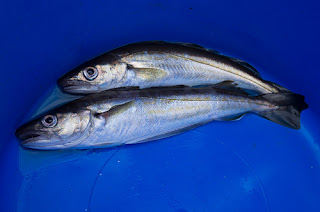Behind the French Menu
by
Bryan G. Newman
behindthefrenchmenu@gmail.com
Whiting
Merlan, Lécaud, Nasellu, Varlet – Whiting; English Whiting; European Whiting; Golden Cutlet; Spelding. Most of the whiting on French menus are caught off France's Atlantic coast or come from fish farms; only rarely is European whiting caught in the Mediterranean. Whiting is a tasty fish with a delicate flesh; the smaller fish may be grilled whole while larger fish will be prepared as filets served with a sauce and poached, sautéed or baked. Whiting, silver hake and blue whiting all tend to get mixed up on menus; these fish are also very similar when cooked, so just eat and enjoy. Whiting will be on menus fresh, and smoked, and frozen filets are in all the supermarkets.
Whiting, European Whiting, on French Menus:
Filet de Merlan Mi-cuit, Compotée de Tomates à la Vanille de Sambava et sa Purée – Filet of whiting, very, very lightly cooked; served with a thickened puree of tomatoes flavored with the highly rated Black Bourbon Vanilla pods from around the town of Sambava in Madagascar. The dish is accompanied by pureed potatoes.
Whiting, red mullet and shrimps.
Merlan de Ligne Poêlé aux Girolles et au Coulis de Poivrons Grillés - Whiting caught at sea, on a rod a line, not, from a fish farm. Here the fish is lightly fried together with girolle chanterelle mushrooms and served with a puree of grilled sweet peppers. When fish are caught at sea the chef will often emphasize the fact, even if they are caught in a net. Fish are very much what they eat.
Whiting
Merlan aux Herbes, Petit-Épeautre – Whiting cooked with herbs and served with small spelt. Small spelt is an ancient grain and today, in France, small spelt is only grown commercially in Provence in France. On some traditional Provencal dishes, small spelt may take the place of rice.
Rillettes de Merlan, Sauce Rouille, Vinaigrette à l'Anis Vert. - Rillettes served with a spicy rouilles and an aniseed-flavored vinaigrette. Rillettes may be made with fish, duck, goose or pork and are on the menu as an hors d’œuvre and sometimes as an entrée. Here the fish rillettes will have been slowly cooked in fat until the fish’s, meat can be made into a paste to spread on toast or bread. The Sauce Rouille is a thick, spicy sauce, made of peppers, tomatoes, garlic, saffron and olive oil all worked into bread or occasionally a potato base. Sauce Rouille is traditionally served alongside bouillabaisse and other fish soups. The diner adds the spicy sauce at his or her discretion to spice the soup or spread on toasted bread with grated cheese and soak in the soup.
Competition for the catch of the day.
Terrine Maison de Merlan aux Crevettes Roses et Laitue de Mer - The chef's pate of whiting with pink shrimps and sea lettuce.
Filets de Merlan
Merlan Poché à l'Huile de Cameline, Asperges - Whiting poached with camelina oil and asparagus. Camelina oil comes from is a flowering plant in also known in English as gold-of-pleasure, or false flax, and German Sesame. This is an ancient plant that was already cultivated by the Celts as for its edible oil. Other vegetables with higher oil production saw Camelina out of the market; however, today the high content of Omega 3 in Camelina has brought the oil back into popularity. Camelina is popular in organic farming as it is resistant to many pests and disease. Use as a seasoning for salads and crudités or after cooking for your vegetables and grains and then camelina oil should not be heated. The whiting is accompanied by asparagus.
The camelina plant.
Years ago whiting was not considered a fish to serve in fine restaurants; in fact, it was a very cheap fish. Today's popularity of the whiting and its close family members show that times, prices and tastes change. Whiting will be starring in the finest restaurants. Whiting caught at sea will be larger and mostly served as filets. Whiting from fish farms will be smaller and may be served whole for a single diner.
European Whiting in the languages of France’s neighbors:
(Catalan - merlà),(Dutch - wijting), (German – wittling or merlan ), (Italian – molo or merlano), (Spanish – liba, merla or merlán).
Merlan Bleu, Merlan de Paris, Merlus –– Blue Whiting. When blue whiting and whiting are cooked and served it will be difficult for an amateur like me to see the difference. The taste will be similar and the occasional confusion on a menu will not be serious. Blue whiting is at home in the Mediterranean while the European whiting is not. In Provence, the merlan, the European whiting, on your menu may well be merlan bleu, blue whiting.
Blue Whiting in the languages of France’s neighbors:
(Catalan – Melu), (Dutch - blauwe wijting), (German - blauer wittling), (Italian – melu or potassolo) (Spanish- bacalá).
Rouget Barbet and Rougets de Roche, Red Mullet and Striped Red Mullet, the Fish on French Menus.
Searching for the meaning of words, names or phrases
on
French menus?
Just add the word, words, or phrase that you are searching for to the words "Behind the French Menu" and search with Google. Behind the French Menu’s links include hundreds of words, names, and phrases that are seen on French menus. There are over 400 articles that include over 3,000 French dishes with English translations and explanations.
Behind the French Menu
by
Bryan G. Newman
behindthefrenchmenu@gmail.com
Copyright 2010, 2016, 2018.





















